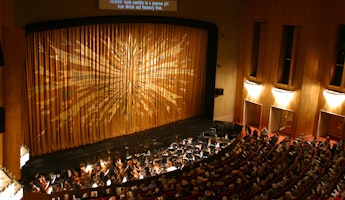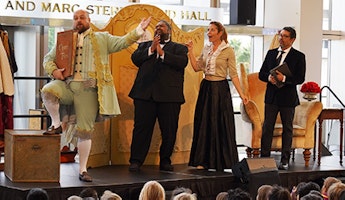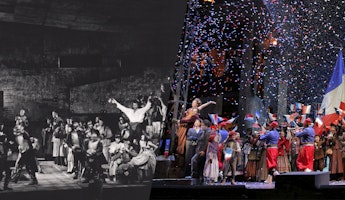Blog
March 9, 2022
Bach and the St. Matthew Passion
A guest blog by Janet E. Bedell
In the mountain range of musical masterpieces, there are a very few that soar beyond the others like Himalayan peaks. If you ask musicians to tell you which ones they are, most will name Johann Sebastian Bach’s St. Matthew Passion as one of them and will add that it is the greatest of all his extraordinary creations. That it was his own most treasured work is clearly indicated by the years of labor he spent producing a definitive score in his most beautiful handwriting with precise instructions for future performers. A work of art in its own right, this score was written in different colors of ink, including red for all the passages from the Bible. Bach kept it by his side until he died, carefully repairing any damage that marred the pages.
Reviewing a recent semi-staged performance by the Berlin Philharmonic, The New Yorker’s Alex Ross eloquently summed up the St. Matthew’s power: “The immensity of Bach’s design—his use of a double chorus and a double orchestra; his interweaving of New Testament storytelling and latter-day meditations; the dramatic, almost operatic quality of the choral writing; the invasive beauty of the lamenting arias, which give the sense that Christ’s death is the acutest of personal losses—has the effect of pulling all of modern life into the Passion scene. … A great rendition of the St. Matthew Passion should have the feeling of an eclipse, of a massive body throwing the world into shadow.”
Premiered in St. Thomas Church in Leipzig —where Bach was the Kapellmeister (leader of musical activities)—at the Good Friday vespers service in 1727, the St. Matthew was the culmination of a long tradition in Germany of reciting the Passion story of Christ’s Crucifixion—found in the four gospels of Matthew, Mark, Luke and John—during Holy Week before Easter. With Martin Luther’s Reformation in the early 16th century, the Bible and the Mass were translated into German. A composer himself, Luther launched the writing of stately German-language chorales, which, sung by Protestant congregations, became a centerpiece of the worship service along with the sermon.
Since coming to St. Thomas in 1723, Bach had been writing quantities of cantatas—short sacred works featuring soloists, chorus and orchestra—that were included in most of the Sunday services. Smaller masterpieces, they prepared him for the challenge of creating a full-blown Passion setting. The first of these was the St. John Passion, premiered in 1724. This was followed three years later by the St. Matthew Passion, using the longer and more vividly told story found in the Gospel of Matthew, Bach’s favorite.
If the St. John was already an impressive work, the St. Matthew was vastly more ambitious in its scope and musical means. Two adult choruses plus a third children’s choir, two chamber orchestras with, ideally, two organs, and six vocal soloists were required. And restless modern listeners would have been sorely challenged by that first 1727 performance, for its nearly three-hour length was imbedded within a full Lutheran service with a sermon lasting upwards of an hour and other worship elements as well. In fact, the reason the St. Matthew is divided into two large parts is because that sermon had to be included in the middle!
Well-read and with critical literary tastes, Bach chose a fellow Leipziger, Christian Friedrich Henrici, who used the pen name Picander, to write the devotional poetry for the solo arias and major choruses that complement the Biblical words sung by the Evangelist and Jesus. Picander’s language tends to be very emotional—and to our present-day ears rather over the top—but it represents the sensibility of the Pietistic movement then dominating German Protestantism. As William Mann explains, “German Lutheranism had become impossibly over-intellectualized and out of touch with ordinary human feelings about God. And so a new movement arose, which its detractors nicknamed Pietism, and the idea was simplicity, humanity, worship in touch with the man in the street.”
A CLOSER LISTEN
In creating a work that is virtually a sacred opera, Bach drew on all the vocal forms extant in the Baroque era. Because being able to clearly hear the Biblical words was of utmost importance, he chose the simplest musical means for the telling of the Passion story. The chief storyteller is the Evangelist, a role for high tenor, who sings in a bare speech-like recitative over occasional chords in the organ and bass. Usually, the Evangelist sings with calm and detachment, but at key moments in the drama—such as Peter’s denial of Jesus during His trial and the earthquake rending the sacred veil of the Temple after Jesus’s death—he breaks out of his confinement with cries of pity and outrage voiced in daring harmonies and biting dissonance.
Sung by a baritone soloist, Jesus’s words are also delivered in recitative, but a lovely string-quartet accompaniment conjures a musical halo around His head. Only when He cries out on the Cross “My God, My God, why has Thou forsaken me?” does that string halo disappear, subtly conveying His sense of loneliness and abandonment. Only once do Jesus’s words blossom into a beautiful, lyrical arioso—when He establishes the rite of the Eucharist at the Last Supper.
Also taking part in the Gospel recitation are singers from the chorus representing Peter, Judas, the High Priest, and Pontius Pilate. And the two choruses also take part, portraying the mob crying for Jesus’s crucifixion and mocking Him on the cross—their brief, but elaborate contrapuntal interjections suggesting members of the crowd individually calling out.
THE CHORALES
Besides the reciting of the Passion story, the other core element of Lutheran Holy Week services was the singing—normally by the congregation—of the traditional Lutheran chorales. There are 14 chorales sung by Bach’s two choruses throughout the work, and he carefully selected which ones and which verses to include. These stirring melodies are not by Bach—though he created the rich harmonizations— but were composed by others, mostly in the 16th century.
The famous chorale “O Sacred Head Now Wounded” appears five times during the Passion after key moments in the story. This tragically beautiful hymn was Bach’s favorite, and he used it many times in other compositions. With each reappearance, he sets it in a progressively lower key, with its final, black-tinged version coming after the Crucifixion. Conductor Nikolaus Harnoncourt: “Bach imparts to this last chorale, the deepest, most personal, and grief-filled feelings upon the death of Christ. Never before had a chorale text been interpreted musically in such emotionally charged harmonies.”
ARIAS OF MEDITATION
Complementing the Gospel story are the many arias, often with companion recitatives, that react to and comment on each scene of the Passion. Picander wrote the contemplative lyrical poetry for these numbers given to the four vocal soloists. Bach was exceptional among his contemporaries for his fascination with instrumental color, and his imaginative choice of obbligato (solo) instruments for these arias added immensely to their emotional affect.
Though it is difficult to choose among such a rich assortment, here are five special moments. Near the end of Part I, when Jesus has been seized by the High Priest’s soldiers, Bach created “So ist mein Jesus nun gefangen,” a remarkable contrapuntal piece—and the St. Matthew Passion’s only duet—for soprano and alto as they lament this perilous situation while the chorus cries out “Unbind him.” Solo flute and oboe keen and wail around them. Suddenly, the two choruses erupt, summoning lightning and thunder to destroy the soldiers, in music of astonishing fire and energy over furious churning in the bass.
Later after Peter has denied Jesus three times, the alto soloist sings the magnificent aria “Erbarme dich,” asking forgiveness for humankind’s frailty. Her accompanist is a solo violin, singing a heartbreakingly beautiful aria of its own. Conductor and Bach scholar John Eliot Gardiner points out that here the composer found a remarkably apt musical parallel for the text: the low-voiced alto cannot reach the violin’s higher notes as she tries to imitate its song.
Equally beautiful is the soprano’s lyrical aria “Aus Liebe,” sung in a gorgeous duet with a solo flute during Jesus’ trial before Pontius Pilate. Gardiner: “An air of timeless healing and benediction emanates from the music of this most sublime of arias and acts as an oasis of temporary sanity in a deranged world.”
As Jesus is carrying His cross to Golgotha, Bach comes up with a perfect instrumental choice for the bass aria “Komm, süsses Kreuz”: the already ancient viola da gamba, whose seven strings make it an extremely ungainly and difficult instrument to play. Its labored sound captures Jesus’s tottering steps as He struggles with the cross.
Many of the arias have companion recitatives, and the alto’s “Ach, Golgotha,” as Jesus dies on the cross, is perhaps the finest. Here two oboes da caccia, snarling lower versions of the oboe, writhe in agony around the singer’s tortured arioso, riddled with strange harmonic twists more in keeping with today’s music than with Baroque practice. In fact, here Bach uses all 12 tones of the chromatic scale—a feat predating Berg and Schoenberg by two centuries.
THREE CHORAL PILLARS
Three epic choruses to Picander poetic texts—at the beginning, the middle, and the end—form the massive supporting pillars for the St. Matthew Passion’s immense structure. “Kommt, ihr Töchter” (“Come, You Daughters”), a vocal expansion of Bach’s famous chorale fantasias for organ, serves as a majestic prelude to the work. Gardiner explains this is conceived as a procession of believers climbing slowly up to hilltop Jerusalem to witness the Crucifixion, with the second chorus calling out questions to the first. The plangent, woodwind-dominated sound of the orchestra adds tragic color to the chorus’s C-minor lament. Midway through, a third chorus of trebles radiantly sings the traditional German Agnus Dei chorale, “O Lamm Gottes,” in unison above the counterpoint of the adults.
In his revision of the St. Matthew in 1736, Bach transferred another chorus, “O Mensch, bewein’ dein’ Sünde gross” (“O Man, Bewail Your Great Sins”), originally intended for his St. John Passion to conclude Part I. This is a moment for reflection on all that has happened in the story so far and all that is to come, and Bach sets it as a classic chorale fantasia, with the chorale tune intoned slowly by the sopranos while the lower three voices weave lovely counterpoint around it. The orchestra surrounds them with a rocking accompaniment expressing grief and contrition.
The final chorus, “We Sit Down in Tears,” is unforgettable. Simple while the other two were complex, it is a tender lullaby for the sleeping Jesus in the C minor key of the opening chorus and the rhythm of a slow sarabande dance. The two choruses fuse as one for the main sections while separating for antiphonal singing in the middle section. In this peaceful, loving chorus, there is an ugly worm: a rogue dissonant note in the oboe that continually pierces the mood of serenity. It tells us that the violence of the Passion story will continue to haunt human history, but through faith and love we can hope for something better.
Janet E. Bedell is a program annotator and feature writer who is the principal writer for Carnegie Hall’s vocal presentations, including song recitals, operas and choral music. For nearly a decade, she has annotated Harry Bicket’s annual series of Handel operas there, as well as recitals by the world’s leading vocal artists. She was the program commentator for Carnegie’s recent complete cycle of Bruckner’s symphonies, led by Daniel Barenboim—the first ever given in a single season in America. She is also a frequent annotator for the Metropolitan Opera.
© 2022 Janet E. Bedell








/03-cosi/_dsc0996_pr.jpg?format=auto&fit=crop&w=345&h=200&auto=format)















